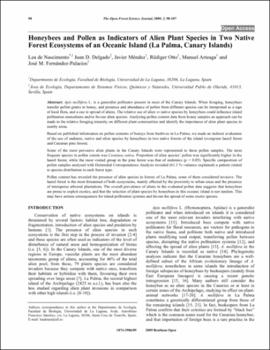Honeybees and Pollen as Indicators of Alien Plant Species in Two Native Forest Ecosystems of an Oceanic Island (La Palma, Canary Islands)
Fecha
2009Resumen
Apis mellifera L. is a generalist pollinator present in most of the Canary Islands. When foraging, honeybees
transfer pollen grains to honey, and presence and abundance of pollen from different species can be interpreted as a sign
of local flora, and a cue to spread of aliens. The relative use of alien vs native species by honeybees could influence island
pollination mutualisms and/or favour alien species. Analyzing pollen content data from honey samples an approach can be
made to the relative foraging intensity on different plant communities and identify the importance of alien plant species in
nearby areas.
Based on published information on pollen contents of honeys from beehives in La Palma, we made an indirect evaluation
of the use of endemic, native and alien species by honeybees in two native forests of the island (evergreen laurel forest
and Canarian pine forest).
Some of the most pervasive alien plants in the Canary Islands were represented in these pollen samples. The most
frequent species in pollen counts was Castanea sativa. Proportion of alien species’ pollen was significantly higher in the
laurel forest, while the most visited group in the pine forest was that of endemics (p < 0.05). Specific composition of
pollen samples analysed with Detrended Correspondence Analysis revealed (61.3 % variance explained) a pattern related
to species distribution in each forest type.
Pollen content has revealed the presence of alien species in forests of La Palma, some of them considered invasive. The
laurel forest is the most threatened of both ecosystems, mainly affected by the proximity to urban areas and the presence
of intersperse arboreal plantations. The overall prevalence of aliens in the evaluated pollen data suggests that honeybees
are prone to exploit exotics, and that the selection of plant species by honeybees in this oceanic island is not random. This
may have serious consequences for island pollination systems and favour the spread of some exotic species.






